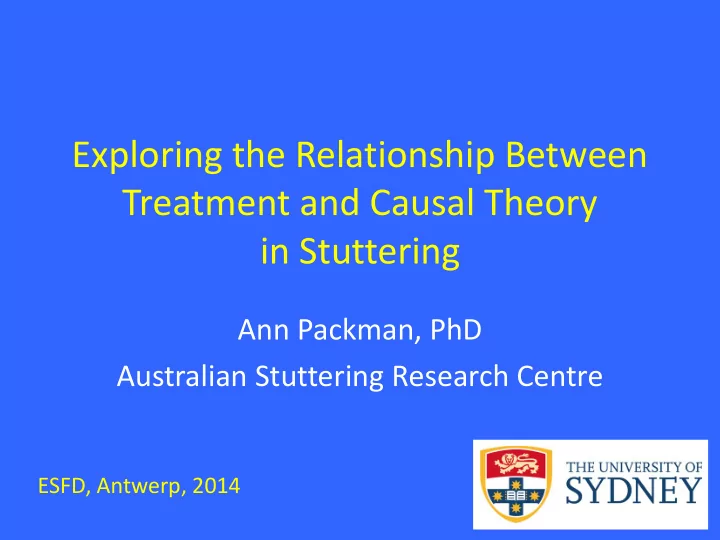

Exploring the Relationship Between Treatment and Causal Theory in Stuttering Ann Packman, PhD Australian Stuttering Research Centre ESFD, Antwerp, 2014
Overview • Verbal communication and complexity theory • “What causes stuttering?” – causal models/theories – P&A 3-factor model • Do our treatments for stuttering address cause?
Spoken language • The most complex thing we humans do – thinking up we want to say – constructing the language to say it – programming this into motor gestures (syllables) – 4-6 syllables per second, each one unique – all this, taking into account • conversational partner • topic • purpose • context
Verbal communication and complexity theory Packman & Kuhn (ODC, 2008; IJSLP, 2009) • Complexity theory/sciences – nonlinear – initial condition and the “butterfly effect” – self-organising and dynamic
Communicative context MIND BRAIN BODY Communicative environment
“What causes stuttering?” • Many models and theories – Systems control modeling • Sensory Motor Modeling Theory • Neuroscience Model • Variability Model (Vmodel) – Speech motor control • Syllable Initiation Theory (SI Theory) • Interhemispheric Interference Model
Models and theories (cont.) – Cognitive and linguistic processing • Neuropsycholinguistic Theory • Covert Repair Hypothesis • Suprasegmental Sentence Plan Alignment Model • EXPLAN – Multifactorial • Demands Capacities • Dynamic Multifactorial Model
Let’s talk about cause Packman & Attanasio (2004) • Cause = necessary and sufficient conditions • Individual instances of a phenomenon can have triggers, e.g. bushfires
Rather than asking… “What causes stuttering?” we ask… “ What causes a moment of stuttering? ”
The Packman & Attanasio (P&A) 3-factor causal model of moments of stuttering Packman (ODC, 2011; JFD, 2012; Enfance, 2013) 1. Necessary neural processing problem 2. Trigger features of spoken language 3. Modulators inherent to the individual
P & A 3-factor model MODULATORS TRIGGER IMPAIRED NEURAL Inherent features of A MOMENT OF PROCESSING spoken STUTTERING for language spoken language • variable syllabic stress • linguistic complexity • physiological arousal • cognitive demands
FACTOR 1 Neural processing problem • Functional – Activations & deactivations • Structural – Volume – Diffusion Tensor Imaging (DTI)
Putting together the findings of recent imaging and genetic research Cykowski et al. (NeuroImage, 2010) Hypothesis: The neural processing problem underlying stuttering is incomplete or late myelination of the white fibre tracts subserving the production of spoken language
FACTOR 2 Variability of syllabic stress Packman et al. (CLP,1996)
FACTOR 2: Effects of linguistic complexity on motor stability see Smith and colleagues ( JSLHR, 2000) “Buy Bobby a puppy” “ You buy Bobby a puppy now if he wants one ”
FACTOR 3 Modulators Alm (JFD, in press), Eggers et al. (JFD, 2013), Jones et al. (JCD, 2014), Metten et al. (Dis. Rehab., 2011) • Determine the triggering threshold – physiological arousal • Anxiety? Excitement? Temperament? • influenced by environment – cognitive demands • multi-tasking
Evaluating the P&A 3-Factor Model • Explanatory power? Stuttering not normal disfluency Onset and development Topography Natural recovery Variability • Testability? • Parsimony? • Heuristic value?
Do our treatments for stuttering address cause? Behavioral treatments Other treatments designed to reduce PSYCHOLOGICAL stuttering (incl. CBT) DIRECT INDIRECT PHARMACEUTICAL MODULATING FACTORS TRIGGER IMPAIRED NEURAL Inherent features of A MOMENT OF PROCESSING spoken STUTTERING for language spoken language • variable syllabic stress • linguistic complexity • physiological arousal • cognitive demands
Theory and therapy Should theory drive therapy? Can therapy drive theory?
Thank you! Dankjewel! �
Alm, P. (2014). Stuttering in relation to anxiety, temperament, and personality: Review and analysis with focus on causality. Journal of Fluency Disorders . In Press. Cykowski, M. D., Fox, P. T., Ingham, R. J., Ingham, J. C., & Robin, D. A. (2010). A study of the reproducibility and etiology of diffusion anisotropy differences in developmental stuttering: A potential role for impaired myelination. NeuroImage, 52 , 1495-1504. Eggers, K., De Nil, L.F. & Van den Bergh, B.RH. (2013). Inhibitory control in childhood stuttering. Journal of Fluency Disorders, 38 , 1-13. Jones, R.M., Conture, E.G. & Walden, T.A. (2014). Emotional reactivity and regulation associated with fluent and stuttered utterances of preschool-age children who stutter. Journal of Communication Disorders . In Press. Kang, C., Riazzudin, S., Mundorff, J., et al. (2010). Mutations in the lysosomal enzyme-targetting pathway and persistent stuttering. The New England Journal of Medicine, 362 , 677-685. Kleinow, J. & Smith, A. (2000). Influences of length and syntactic complexity on the speech motor stability of the fluent speech of adults who stutter . Journal of Speech, Language and Hearing Research, 43 , 548-559 Kraft, S.J.& Yairi, E. (2011). Genetic bases of stuttering: The state of the art, 2011. Folia Phoniatrica et Logopaedia, 64 , 34-47. Maner, K.J., Smith, A. & Grayson, A. (2000). Influences of utterance length and complexity on speech motor performance of children and adults. Journal of Speech, Language and Hearing Research, 43 , 560-573. Metten, C., Bosshardt, H.G., Jones, M., Eisenhuth, J., Block, S., Carey, B., O'Brian, S., Packman, A., Onslow, M., Menzies. R. (2011). Dual Tasking and stuttering: From the laboratory to the clinic. Disability and Rehabilitation, 33, 933-944 . Namasivayam, A.K. & Van Lieshout, P. (2011). Speech motor skill and stuttering. Journal of Motor Behavior, 43 , 477-489. Oomen, C.E. & Postma, A. (2001). Effects of divided attention on the production of filled pauses and repetitions. Journal of Speech, Language, and Hearing Research, 44 , 997-1004. Packman, A. (2012). Theory and therapy: Exploring a complex relationship. Journal of Fluency Disorders , 37, 225-233. Packman, A. (2013). La cause du bégaiement de l’enfant . Enfance, 3 , 207-216. Packman, A., & Attanasio, J. (2004). Theoretical issues in stuttering . London, UK: Psychology Press. Packman, A. & Kuhn, L. (2009). Looking at stuttering through the lens of complexity. International Journal of Speech-Language Pathology, 11 , 77-82. Packman, A., Onslow, M., Richard, F. & van Doorn, J. (1996). Syllabic stress and variability: a model of stuttering. Clinical Linguistics and Phonetics, 19 , 235-263.
Recommend
More recommend